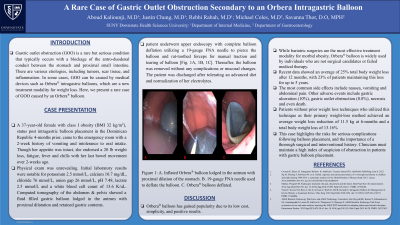Sunday Poster Session
Category: Stomach
P1373 - A Rare Case of Gastric Outlet Obstruction Secondary to an Orbera Intra-Gastric Balloon
Sunday, October 22, 2023
3:30 PM - 7:00 PM PT
Location: Exhibit Hall

Has Audio

Aboud Kaliounji, MD
SUNY Downstate Health Sciences University
Brooklyn, NY
Presenting Author(s)
Aboud Kaliounji, MD, Justin Chung, MD, Rebhi Rabah, MD, Michael Coles, MD, Savanna Thor, DO, MPH
SUNY Downstate Health Sciences University, Brooklyn, NY
Introduction: Gastric outlet obstruction (GOO) is a rare but serious condition that typically occurs with a blockage of the antro-duodenal conduit between the stomach and proximal small intestine. There are various etiologies, including tumors, scar tissue, and inflammation. In some cases, GOO can be caused by medical devices such as Orbera® intragastric balloons, which are a new treatment modality for weight loss. Here, we present a rare case of GOO caused by an Orbera® balloon.
Case Description/Methods: A 37-year-old female with class I obesity (BMI 32 kg/m2), status post intra-gastric balloon placement in the Dominican Republic 4 months prior, came to the emergency room with a 2-week history of vomiting and intolerance to oral intake. She also endorsed a 20 lb. weight loss, fatigue, fever and chills, and had not had a bowel movement for 2 weeks. Physical exam was unrevealing. Initial laboratory results were notable for potassium 2.5 mmol/L, calcium 10.7 mg/dL, chloride 76 mmol/L, anion gap 26 mmol/L, pH 7.48, lactate 2.5 mmol/L and a white blood cell count of 13.6 K/uL. Computed tomography of the abdomen & pelvis showed a fluid filled gastric balloon lodged in the antrum with proximal dilatation and retained gastric contents. Patient underwent upper endoscopy with complete ballon deflation utilizing a 19-gauge FNA needle to pierce the balloon and rat-toothed forceps for manual traction and tearing of balloon [Fig. 1A, 1B, 1C]. Thereafter, the balloon was removed without any complications or mucosal changes. The patient was discharged after tolerating a regular diet and normalization of her electrolytes.
Discussion: Orbera® balloon has gained popularity due to its low cost, simplicity, and effective weight loss. While bariatric surgeries are the most effective treatment modality for morbid obesity, Orbera® balloon is widely used by those who are not surgical candidates or failed medical therapy. Recent data showed an average of 25% total body weight loss after 12 months, with 23% of patients maintaining this loss for up to 5 years. The most common side effects include nausea, vomiting and abdominal pain. Other adverse events include gastric ulceration (10%), gastric outlet obstruction (0.8%), necrosis and even death. This case highlights the risks for serious complications following balloon placement, and the importance of a thorough surgical and interventional history. Clinicians must maintain a high index of suspicion of obstruction in patients with gastric balloon placement.

Disclosures:
Aboud Kaliounji, MD, Justin Chung, MD, Rebhi Rabah, MD, Michael Coles, MD, Savanna Thor, DO, MPH. P1373 - A Rare Case of Gastric Outlet Obstruction Secondary to an Orbera Intra-Gastric Balloon, ACG 2023 Annual Scientific Meeting Abstracts. Vancouver, BC, Canada: American College of Gastroenterology.
SUNY Downstate Health Sciences University, Brooklyn, NY
Introduction: Gastric outlet obstruction (GOO) is a rare but serious condition that typically occurs with a blockage of the antro-duodenal conduit between the stomach and proximal small intestine. There are various etiologies, including tumors, scar tissue, and inflammation. In some cases, GOO can be caused by medical devices such as Orbera® intragastric balloons, which are a new treatment modality for weight loss. Here, we present a rare case of GOO caused by an Orbera® balloon.
Case Description/Methods: A 37-year-old female with class I obesity (BMI 32 kg/m2), status post intra-gastric balloon placement in the Dominican Republic 4 months prior, came to the emergency room with a 2-week history of vomiting and intolerance to oral intake. She also endorsed a 20 lb. weight loss, fatigue, fever and chills, and had not had a bowel movement for 2 weeks. Physical exam was unrevealing. Initial laboratory results were notable for potassium 2.5 mmol/L, calcium 10.7 mg/dL, chloride 76 mmol/L, anion gap 26 mmol/L, pH 7.48, lactate 2.5 mmol/L and a white blood cell count of 13.6 K/uL. Computed tomography of the abdomen & pelvis showed a fluid filled gastric balloon lodged in the antrum with proximal dilatation and retained gastric contents. Patient underwent upper endoscopy with complete ballon deflation utilizing a 19-gauge FNA needle to pierce the balloon and rat-toothed forceps for manual traction and tearing of balloon [Fig. 1A, 1B, 1C]. Thereafter, the balloon was removed without any complications or mucosal changes. The patient was discharged after tolerating a regular diet and normalization of her electrolytes.
Discussion: Orbera® balloon has gained popularity due to its low cost, simplicity, and effective weight loss. While bariatric surgeries are the most effective treatment modality for morbid obesity, Orbera® balloon is widely used by those who are not surgical candidates or failed medical therapy. Recent data showed an average of 25% total body weight loss after 12 months, with 23% of patients maintaining this loss for up to 5 years. The most common side effects include nausea, vomiting and abdominal pain. Other adverse events include gastric ulceration (10%), gastric outlet obstruction (0.8%), necrosis and even death. This case highlights the risks for serious complications following balloon placement, and the importance of a thorough surgical and interventional history. Clinicians must maintain a high index of suspicion of obstruction in patients with gastric balloon placement.

Figure: Figure 1: A. Inflated Orbera® balloon lodged in the antrum with proximal dilation of the stomach. B. 19-gauge FNA needle used to deflate the balloon. C. Orbera® balloon deflated.
Disclosures:
Aboud Kaliounji indicated no relevant financial relationships.
Justin Chung indicated no relevant financial relationships.
Rebhi Rabah indicated no relevant financial relationships.
Michael Coles indicated no relevant financial relationships.
Savanna Thor indicated no relevant financial relationships.
Aboud Kaliounji, MD, Justin Chung, MD, Rebhi Rabah, MD, Michael Coles, MD, Savanna Thor, DO, MPH. P1373 - A Rare Case of Gastric Outlet Obstruction Secondary to an Orbera Intra-Gastric Balloon, ACG 2023 Annual Scientific Meeting Abstracts. Vancouver, BC, Canada: American College of Gastroenterology.
